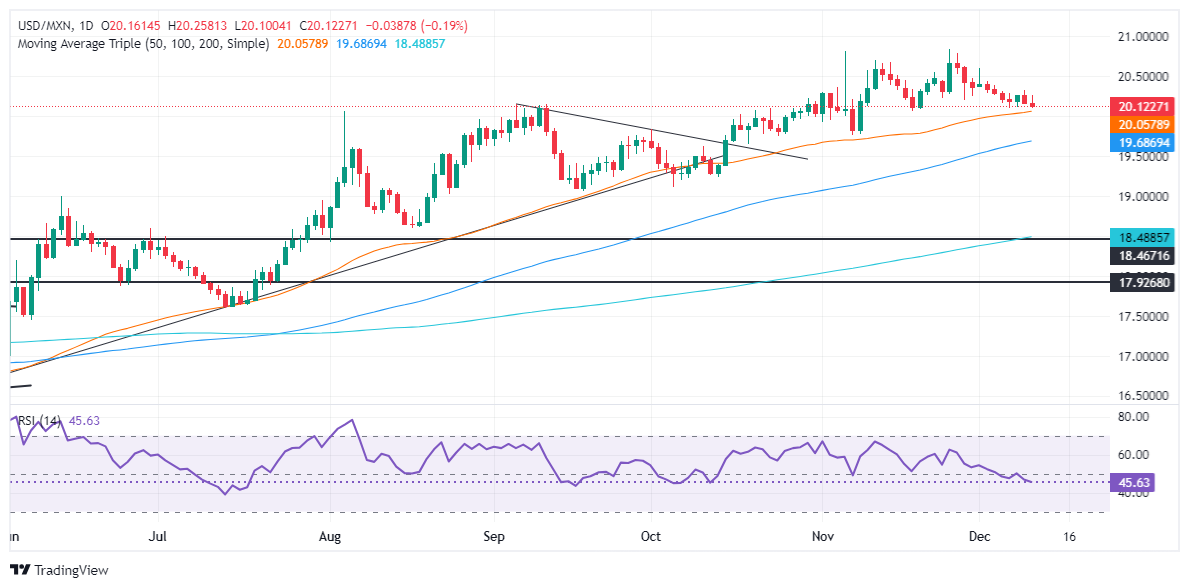Mexican Peso strengthens as US CPI supports Fed rate cut speculation
- Mexican Peso appreciates as US November inflation data meets estimates, favoring Fed’s easing.
- Mexico’s inflation continues to edge lower, enhancing prospects for a bigger Banxico rate cut.
- Investors anticipate a 25 bps rate cut by the Federal Reserve on December 18 with odds standing at 92%.
The Mexican Peso extended its gains on Wednesday after US economic data showed that November inflation was aligned with estimates, cementing the case for an interest rate cut by the Federal Reserve (Fed). Consequently, the US Dollar weakened and weighed on the USD/MXN, which traded at 20.11, down over 0.24%.
On Wednesday, US headline and core inflation prints in November were as expected. After the US Consumer Price Index (CPI) release, traders priced in a 92% chance that the Fed would lower interest rates by 25 basis points (bps) on December 18.
US Treasury yields edged lower, while the USD/MXN tumbled beneath 20.20, extending its losses as the Peso appreciated against the Greenback.
Mexico’s economic docket remains scarce on Wednesday, but traders had already digested the release of softer than expected Mexican CPI figures in November. Prior in the week the CPI showed that the disinflation process continues to evolve as headline inflation dipped from 4.76% to 4.55%, while underlying inflation dropped from 3.80% to 3.58%.
Following the data, JPMorgan hinted that the Bank of Mexico (Banxico) might lower rates by 50 basis points (bps), as inflation data shows that prices are edging lower faster than expected. “It is true that if there is a window of opportunity to deliver a 50bp rate cut and recalibrate policy to a less restrictive stance, it is now,” analysts wrote in their note on Monday.
This week, Mexico’s schedule will feature October’s Industrial Production data. In the US, the docket will reveal the Producer Price Index (PPI) for November on Thursday, alongside Initial Jobless Claims for the week ending December 7.
Daily digest market movers: Mexican Peso extends losses below 20.20
- Mexico’s Industrial Production is expected to contract -0.2% MoM in October, down from 0.6% in September. On an annual basis, the economists project production to drop from -0.4% to -0.6% YoY.
- The swaps market suggests Banxico will cut interest rates by 25 basis points at the December 19 meeting.
- US Treasury bond yields slipped with the 10-year T-note coupon diving to a low of 4.201% before recovering to 4.26%, up three basis points.
- The US Dollar Index rises by 0.24% to 106.63.
- Banxico’s Governor, Victoria Rodriguez Ceja, remains dovish. In her last interview with Reuters, she said that given the progress of disinflation, the central bank could continue lowering borrowing costs.
Mexican Peso technical outlook: USD/MXN stumbles below 20.15 on strong Peso
The USD/MXN remains downwardly biased after clearing the 20.20 figure but remains shy of clearing the 50-day Simple Moving Average (SMA) of 20.03.
Momentum, as measured by the Relative Strength Index (RSI), suggests that sellers are in charge. This means that further USD/MXN downside is expected.
If USD/MXN drops below the 50-day SMA, the next support would be 20.00. A breach of the latter will expose the 100-day SMA at 19.66, followed by the psychological 19.50 figure. Once surpassed, the next stop would be the 19.00 mark.
Conversely, if USD/MXN soars above the December 6 high of 20.28, that could pave the way to challenge 20.50, ahead of the year-to-date peak at 20.82, followed by the 21.00 mark.
Mexican Peso FAQs
The Mexican Peso (MXN) is the most traded currency among its Latin American peers. Its value is broadly determined by the performance of the Mexican economy, the country’s central bank’s policy, the amount of foreign investment in the country and even the levels of remittances sent by Mexicans who live abroad, particularly in the United States. Geopolitical trends can also move MXN: for example, the process of nearshoring – or the decision by some firms to relocate manufacturing capacity and supply chains closer to their home countries – is also seen as a catalyst for the Mexican currency as the country is considered a key manufacturing hub in the American continent. Another catalyst for MXN is Oil prices as Mexico is a key exporter of the commodity.
The main objective of Mexico’s central bank, also known as Banxico, is to maintain inflation at low and stable levels (at or close to its target of 3%, the midpoint in a tolerance band of between 2% and 4%). To this end, the bank sets an appropriate level of interest rates. When inflation is too high, Banxico will attempt to tame it by raising interest rates, making it more expensive for households and businesses to borrow money, thus cooling demand and the overall economy. Higher interest rates are generally positive for the Mexican Peso (MXN) as they lead to higher yields, making the country a more attractive place for investors. On the contrary, lower interest rates tend to weaken MXN.
Macroeconomic data releases are key to assess the state of the economy and can have an impact on the Mexican Peso (MXN) valuation. A strong Mexican economy, based on high economic growth, low unemployment and high confidence is good for MXN. Not only does it attract more foreign investment but it may encourage the Bank of Mexico (Banxico) to increase interest rates, particularly if this strength comes together with elevated inflation. However, if economic data is weak, MXN is likely to depreciate.
As an emerging-market currency, the Mexican Peso (MXN) tends to strive during risk-on periods, or when investors perceive that broader market risks are low and thus are eager to engage with investments that carry a higher risk. Conversely, MXN tends to weaken at times of market turbulence or economic uncertainty as investors tend to sell higher-risk assets and flee to the more-stable safe havens.



